7 books about Alaska, Southwest
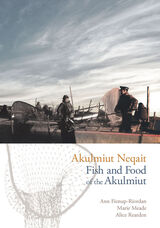
Akulmiut Neqait / Fish and Food of the Akulmiut
Ann Fienup-Riordan, Marie Meade, and Alice Rearden
University of Alaska Press, 2019
For centuries, the Akulmiut people—a Yup’ik group—have been sustained by the annual movements of whitefish. It is a food that sustains and defines them. To this day, many Akulmiut view not only their actions in the world, but their interactions with each other, as having a direct and profound effect on these fish. Not only are fish viewed as responding to human action and intention in many contexts, but the lakes and rivers fish inhabit are likewise viewed as sentient beings, with the ability to respond both positively and negatively to those who travel there.
This bilingual book details the lives of the Akulmiut living in the lake country west of Bethel, Alaska, in the villages of Kasigluk, Nunapitchuk, and Atmautluak. Akulmiut Neqait is based in conversations recorded with the people of these villages as they talk about their uniquely Yup'ik view of the world and how it has weathered periods of immense change in southwest Alaska. While many predicted that globalization would sound the death knoll for many distinctive traditions, these conversations show that Indigenous people all over the planet have sought to appropriate the world in their own terms. For all their new connectedness, the continued relevance of traditional admonitions cannot be denied.
This bilingual book details the lives of the Akulmiut living in the lake country west of Bethel, Alaska, in the villages of Kasigluk, Nunapitchuk, and Atmautluak. Akulmiut Neqait is based in conversations recorded with the people of these villages as they talk about their uniquely Yup'ik view of the world and how it has weathered periods of immense change in southwest Alaska. While many predicted that globalization would sound the death knoll for many distinctive traditions, these conversations show that Indigenous people all over the planet have sought to appropriate the world in their own terms. For all their new connectedness, the continued relevance of traditional admonitions cannot be denied.
[more]
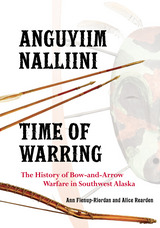
Anguyiim Nalliini/Time of Warring
The History of Bow-and-Arrow Warfare in Southwest Alaska
Ann Fienup-Riordan and Alice Rearden
University of Alaska Press, 2016
This book draws on little-known oral histories from the Yup’ik people of southwest Alaska to detail a period of bow-and-arrow warfare that took place in the region between 1300 and 1800. The result of more than thirty years of research, discussion, and field recordings involving more than one hundred Yup’ik men and women, Anguyiim Nalliini tells a story not just of war and violence, but also of its cultural context—the origins of place names, the growth of indigenous architectural practices, the personalities of prominent warriors and leaders, and the eventual establishment of peaceful coexistence.
The book is presented in bilingual format, with facing-page translations, and it will be hailed as a landmark work in the study of Alaska Native history and anthropology.
The book is presented in bilingual format, with facing-page translations, and it will be hailed as a landmark work in the study of Alaska Native history and anthropology.
[more]
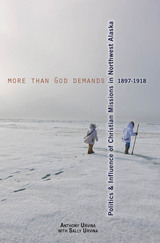
More Than God Demands
Politics and Influence of Christian Missions in Northwest Alaska, 1897-1918
Anthony Urvina with Sally Urvina
University of Alaska Press, 2016
Near the turn of the twentieth century, the territorial government of Alaska put its support behind a project led by Christian missionaries to convert Alaska Native peoples—and, along the way, bring them into “civilized” American citizenship. Establishing missions in a number of areas inhabited by Alaska Natives, the program was an explicit attempt to erase ten thousand years of Native culture and replace it with Christianity and an American frontier ethic.
Anthony Urvina, whose mother was an orphan raised at one of the missions established as part of this program, draws on details from her life in order to present the first full history of this missionary effort. Smoothly combining personal and regional history, he tells the story of his mother’s experience amid a fascinating account of Alaska Native life and of the men and women who came to Alaska to spread the word of Christ, confident in their belief and unable to see the power of the ancient traditions they aimed to supplant.
Anthony Urvina, whose mother was an orphan raised at one of the missions established as part of this program, draws on details from her life in order to present the first full history of this missionary effort. Smoothly combining personal and regional history, he tells the story of his mother’s experience amid a fascinating account of Alaska Native life and of the men and women who came to Alaska to spread the word of Christ, confident in their belief and unable to see the power of the ancient traditions they aimed to supplant.
[more]
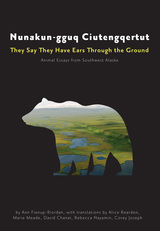
Nunakun-gguq Ciutengqertut/They Say They Have Ears Through the Ground
Animal Essays from Southwest Alaska
Ann Fienup-Riordan
University of Alaska Press, 2020
Lifeways in Southwest Alaska today remains inextricably bound to the seasonal cycles of sea and land. Community members continue to hunt, fish, and make products from the life found in the rivers and sea. Based on a wealth of oral histories collected over decades of research, this book explores the ancestral relationship between Yup’ik people and the natural world of Southwest Alaska. Nunakun-gguq Ciutengqertut studies the overlapping lives of the Yup’ik with native plants, animals, and birds, and traces how these relationships transform as more Yup’ik people relocate to urban areas and with the changing environment. The book will be hailed as a milestone work in the anthropological study of contemporary Alaska.
[more]
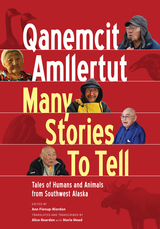
Qanemcit Amllertut/Many Stories to Tell
Tales of Humans and Animals from Southwest Alaska
Edited by Ann Fienup-Riordan
University of Alaska Press, 2017
This bilingual collection shares new translations of old stories recorded over the last four decades though interviews with Yup’ik elders from throughout southwest Alaska. Some are true qulirat (traditional tales), while others are recent. Some are well known, like the adventures of the wily Raven, while others are rarely told. All are part of a great narrative tradition, shared and treasured by Yup’ik people into the present day.
This is the first region-wide collection of traditional Yup’ik tales and stories from Southwest Alaska. The elders and translators who contributed to this collection embrace the great irony of oral traditions: that the best way to keep these stories is to give them away. By retelling these stories, they hope to create a future in which the Yup’ik view of the world will be both recognized and valued.
This is the first region-wide collection of traditional Yup’ik tales and stories from Southwest Alaska. The elders and translators who contributed to this collection embrace the great irony of oral traditions: that the best way to keep these stories is to give them away. By retelling these stories, they hope to create a future in which the Yup’ik view of the world will be both recognized and valued.
[more]
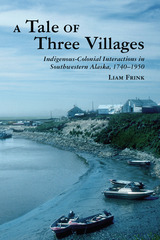
A Tale of Three Villages
Indigenous-Colonial Interactions in Southwestern Alaska, 1740–1950
Liam Frink
University of Arizona Press, 2016
People are often able to identify change agents. They can estimate possible economic and social transitions, and they are often in an economic or social position to make calculated—sometimes risky—choices. Exploring this dynamic, A Tale of Three Villages is an investigation of culture change among the Yup’ik Eskimo people of the southwestern Alaskan coast from just prior to the time of Russian and Euro-North American contact to the mid-twentieth century.
Liam Frink focuses on three indigenous-colonial events along the southwestern Alaskan coast: the late precolonial end of warfare and raiding, the commodification of subsistence that followed, and, finally, the engagement with institutional religion. Frink’s innovative interdisciplinary methodology respectfully and creatively investigates the spatial and material past, using archaeological, ethnoecological, and archival sources.
The author’s narrative journey tracks the histories of three villages ancestrally linked to Chevak, a contemporary Alaskan Native community: Qavinaq, a prehistoric village at the precipice of colonial interactions and devastated by regional warfare; Kashunak, where people lived during the infancy and growth of the commercial market and colonial religion; and Old Chevak, a briefly occupied “stepping-stone” village inhabited just prior to modern Chevak. The archaeological spatial data from the sites are blended with ethnohistoric documents, local oral histories, eyewitness accounts of people who lived at two of the villages, and Frink’s nearly two decades of participant-observation in the region.
Frink provides a model for work that examines interfaces among indigenous women and men, old and young, demonstrating that it is as important as understanding their interactions with colonizers. He demonstrates that in order to understand colonial history, we must actively incorporate indigenous people as actors, not merely as reactors.
Liam Frink focuses on three indigenous-colonial events along the southwestern Alaskan coast: the late precolonial end of warfare and raiding, the commodification of subsistence that followed, and, finally, the engagement with institutional religion. Frink’s innovative interdisciplinary methodology respectfully and creatively investigates the spatial and material past, using archaeological, ethnoecological, and archival sources.
The author’s narrative journey tracks the histories of three villages ancestrally linked to Chevak, a contemporary Alaskan Native community: Qavinaq, a prehistoric village at the precipice of colonial interactions and devastated by regional warfare; Kashunak, where people lived during the infancy and growth of the commercial market and colonial religion; and Old Chevak, a briefly occupied “stepping-stone” village inhabited just prior to modern Chevak. The archaeological spatial data from the sites are blended with ethnohistoric documents, local oral histories, eyewitness accounts of people who lived at two of the villages, and Frink’s nearly two decades of participant-observation in the region.
Frink provides a model for work that examines interfaces among indigenous women and men, old and young, demonstrating that it is as important as understanding their interactions with colonizers. He demonstrates that in order to understand colonial history, we must actively incorporate indigenous people as actors, not merely as reactors.
[more]
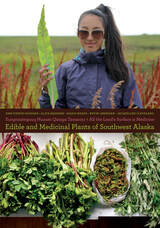
Yungcautnguuq Nunam Qainga Tamarmi/All the Land's Surface is Medicine
Edible and Medicinal Plants of Southwest Alaska
Ann Fienup-Riordan
University of Alaska Press, 2020
In this book, close to one hundred men and women from all over southwest Alaska share knowledge of their homeland and the plants that grow there. They speak eloquently about time spent gathering and storing plants and plant material during snow-free months, including gathering greens during spring, picking berries each summer, harvesting tubers from the caches of tundra voles, and gathering a variety of medicinal plants. The book is intended as a guide to the identification and use of edible and medicinal plants in southwest Alaska, but also as an enduring record of what Yup’ik men and women know and value about plants and the roles plants continue to play in Yup’ik lives.
[more]
READERS
Browse our collection.
PUBLISHERS
See BiblioVault's publisher services.
STUDENT SERVICES
Files for college accessibility offices.
UChicago Accessibility Resources
home | accessibility | search | about | contact us
BiblioVault ® 2001 - 2024
The University of Chicago Press









